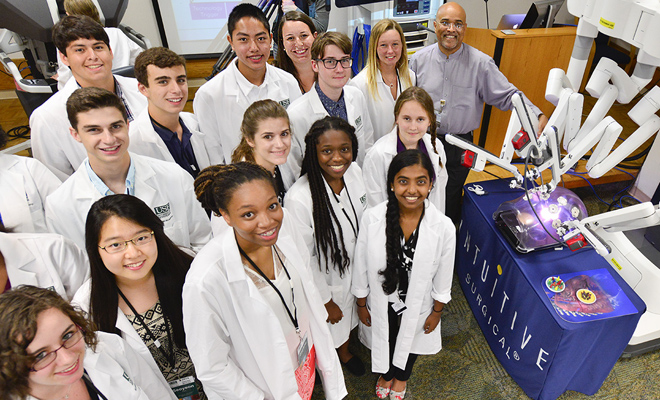Forehead buried in a surgery console, Savannah Summy, 16, appeared intent on tying a knot in the suture thread using micro-movements of the robotic instruments she controlled remotely. Nearby, interactive robot arms outfitted with graspers and needles were poised over a small cushion holding the surgical string.
Dr. Lennox Hoyte, professor of obstetrics and gynecology and director of robotic surgery at the USF Health Morsani College of Medicine and Tampa General Hospital, demonstrated the twisting wrist action that could help Summy loop the string by guiding the robot arm.
“It’s like you’re turning a key,” said Summy as Dr. Hoyte’s keyhole analogy clicked. “There’s definitely a learning curve, but it’s very cool.”

Savannah Summy, 16, seated at the surgery console, concentrates on operating the robotic arms nearby to tie surgical string, with encouragement from a fellow USF Stem Academy student.
Summy got an enthusiastic high-five from a fellow student after successfully completing the precision task with step-by-step coaching from Dr. Hoyte, a pioneer in urogynecologic robotic surgery.
A student at Clearwater High School, Summy was one of 22 rising junior and senior high school students across Florida, including one from Georgia, who participated last week in the STEM Academy on Diabetes & Medicine, a USF Pre-College summer program. Another group of 18 students completed the program this June.
Both groups visited TGHwhere they were provided the opportunity for some supervised hands-on practice with one of the hospital’s state-of-the-art surgical robotic systems.
This robotics session led by Dr. Hoyte scored as “a major wow factor” with students, said Richard Pollenz, PhD, professor of cell biology and director of USF’s Office for Undergraduate Research, who develops and manages the STEM Academy program.

One of the supervised exercises students practiced at Tampa General Hospital was using the robot to flip a penny.
The academically intensive six-day residential program immerses students in scientific inquiry, creative activities and hands-on research, with the intent of fanning the flames of their interest in the critical STEM fields – science (including the health sciences), technology, engineering and math. USF and other public universities are working to boost the number of students selecting and graduating with hard-core science and technology majors.
Now in its third year, the USF STEM Academy has demonstrated some early success. Ten students from the course’s 2012 and 2013 sessions enrolled at USF and several are pursuing STEM disciplines in the Honors College, Dr. Pollenz said.
In addition to trying their hands at manipulating the robot arms to tie knots and flip pennies, the students practiced a simulation exercise in which they cauterized tiny blood vessels.
Other activities last week included extracting DNA from their own cheeks to perform a DNA gel electrophoresis, conducting field research at Fort DeSoto Park with USF College of Marine Science faculty and students, visiting several university research centers to network with faculty, working in groups to problem solve, and interacting with STEM Academy mentors to develop creative solutions to a Grand Challenge Problem on diabetes.

Dr. Lennox Hoyte, director of robotic surgery at USF Health and Tampa General Hospital, coaches a student (not pictured) guiding the robot to flip a penny, while some USF STEM Academy students observe. The group watches the procedure in real time on a monitor above (not pictured).
One morning the students toured the USF Diabetes Center with Clinical Director Dr. Henry Rodriguez to learn about the education and research conducted there. They pricked their fingers to draw their own blood, just like people with type 1 diabetes do several time a day to test their blood sugar. The next day they used high-end digital pipettes to conduct an ELISA assay to measure the amount of insulin in their blood.
“These are experimental procedures typically carried out by college sophmores and juniors,” Dr. Pollenz said.
For Summy, who has type 1 diabetes, the laboratory exercise was a fascinating glimpse into the basic science underlying management of the chronic disease.
“I’m interested in doing something in the diabetes field, but I’m trying to determine whether I want to work in patient care or in a research laboratory,” she said. “Do I want to be a pediatric endocrinologist, or help develop the science and technology that may lead to advances or a cure?”

Giving students the opportunity to explore career options available to those with STEM degrees is an important aspect of the program, along with promoting scientific inquiry, relationship building and teamwork.
“Students who enter college with exposure to state-of-the-art STEM research are uniquely positioned to engage in undergraduate research activities that will enhance their academic performance and provide them with a competitive advantage in the job market and admission to graduate and professional programs,” Dr. Pollenz said.
“My goal is to inspire them to keep their scientific minds alive — to ask meaningful questions and think about how technology can be developed to solve complex human problems,” Dr. Hoyte said.
“It’s all about teaching these students how to collaborate and apply their knowledge.”

.

Savannah Summy

.
Photos by Eric Younghans, USF Health Communications
